“You don’t have to be great to start, but you have to start to be great.” – Zig Ziglar. Starting your day with a protein-rich meal can make all the difference in your energy levels and overall health.
Including protein in your diet is essential for muscle maintenance, metabolism, and overall wellbeing. With everyday kitchen foods, you can create delicious and nutritious meals that support your health and fitness goals.
These meals are not only easy to prepare but also packed with at least 15 grams of protein per serving. By combining common ingredients in new ways, you can create nutritionally balanced meals that fit various dietary preferences.
Key Takeaways
- Transform everyday kitchen staples into protein-packed meals.
- Understand the importance of protein for muscle maintenance and overall health.
- Explore easy-to-prepare recipes with significant protein content.
- Learn to combine common foods for nutritionally balanced meals.
- Customize protein-rich recipes to suit your taste preferences.
The Power of Protein in Your Daily Diet
Understanding the power of protein in your diet can significantly impact your health, fitness, and daily energy levels. Protein is not just a nutrient; it’s a building block for muscles, enzymes, and hormones, making it essential for virtually every bodily function.
Besides being necessary for every bodily function, protein fills you up and keeps you satisfied longer. Including protein in each meal or snack also helps stabilize your blood sugar and can prevent that “hangry” feeling.
Why Protein Matters for Health and Fitness
Adequate protein intake supports muscle recovery after exercise and helps maintain lean muscle mass even during weight loss. This makes protein crucial for individuals looking to improve their fitness or manage their weight.
How Much Protein Do You Need Daily?
The recommended daily protein intake varies based on factors like age, weight, activity level, and fitness goals. Understanding your personal protein needs and distributing protein intake throughout the day is key for optimal absorption and utilization.
What Makes a Recipe High in Protein?
Understanding what constitutes a high-protein recipe is crucial for maintaining a balanced diet. A high-protein recipe typically includes a significant amount of protein-rich foods.
A key factor is the type of protein sources used. Complete proteins, like eggs, contain all nine essential amino acids necessary for the body.
Complete vs. Incomplete Protein Sources
Complete proteins are found in animal products and some plant-based combinations. In contrast, incomplete proteins lack one or more essential amino acids.
| Protein Source | Complete/Incomplete | Examples |
|---|---|---|
| Animal-Based | Complete | Eggs, Meat, Fish |
| Plant-Based | Incomplete | Legumes, Grains |
| Combined Plant-Based | Complete | Rice & Beans, Hummus & Whole Wheat |
Balancing Macronutrients for Optimal Nutrition
Balancing protein with carbohydrates and healthy fats is vital for nutrition and sustained energy. A well-balanced recipe ensures optimal nutrition.
For example, pairing protein-rich food with complex carbohydrates and vegetables creates a nutritious meal. Understanding sources of protein and other macronutrients helps in crafting a balanced recipe.
Essential Protein-Rich Ingredients in Your Kitchen
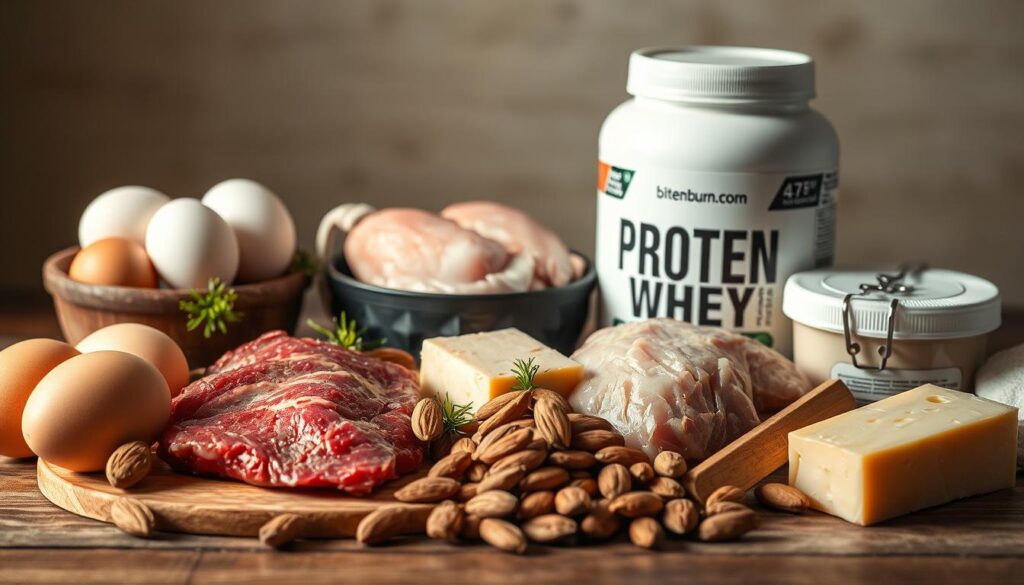
Stocking your kitchen with the right ingredients is crucial for preparing high-protein meals. Having a variety of protein sources on hand allows you to create diverse and nutritious dishes.
To get started, let’s explore the different categories of protein-rich foods.
Animal-Based Protein Sources
Animal-based protein sources include lean meats like chicken breast, turkey, and fish, as well as beef and pork. These options are not only rich in protein but also provide essential nutrients like iron and zinc.
Plant-Based Protein Powerhouses
For those following a plant-based diet, ingredients like chickpeas, lentils, beans, tofu, and quinoa are excellent sources of protein. These foods are versatile and can be incorporated into a variety of dishes.
Dairy and Egg Protein Options
Dairy products like Greek yogurt and cottage cheese, along with eggs, are rich in protein and offer additional nutrients like calcium and vitamin D. These ingredients can be used in both savory and sweet recipes.
Quick Chicken Caprese with Protein-Packed Sides

Transform the classic Caprese salad into a protein-rich main dish with our Quick Chicken Caprese recipe. This dish combines the freshness of tomatoes and basil with the satisfying protein of grilled chicken breast.
Ingredients List
The ingredients required for this recipe include: 1 lb grilled chicken breast, 2 large tomatoes, 8 oz fresh mozzarella cheese, 1/4 cup fresh basil leaves, 2 tbsp olive oil, 1 tbsp balsamic glaze, salt, and pepper.
Step-by-Step Preparation
To prepare the Quick Chicken Caprese, start by slicing the grilled chicken breast into thin strips. Layer the chicken, tomatoes, and mozzarella cheese on a plate or sandwich bun. Drizzle with olive oil and balsamic glaze, then season with salt and pepper. Garnish with chopped fresh basil leaves. This simple recipe is quick to assemble and can be ready in no time.
Nutritional Information and Protein Content
This recipe is not only delicious but also packed with nutrients. The grilled chicken breast provides a significant amount of protein, while the tomatoes and basil add vitamins and antioxidants. The mozzarella cheese contributes to the calcium content, making this a well-rounded meal with a good balance of protein and other essential nutrients.
Hearty Salmon and Quinoa Power Bowl
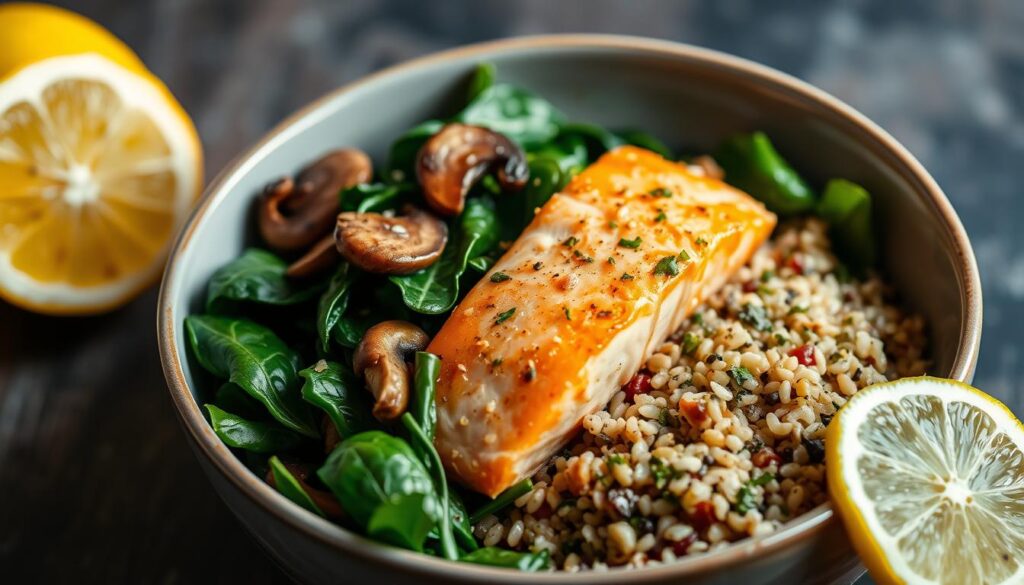
A Salmon and Quinoa Power Bowl is an excellent way to enjoy a meal that’s both satisfying and rich in nutrients, featuring salmon as the main protein source. This dish combines the heart-healthy benefits of salmon with the protein-rich goodness of quinoa, making it a perfect option for a healthy dinner.
Ingredients List
The ingredients for this recipe include salmon fillets, quinoa, fresh spinach, mushrooms, lemon juice, and parmesan cheese. These components come together to create a nutrient-dense meal.
Step-by-Step Preparation
To prepare this power bowl, start by cooking the quinoa according to package instructions. Meanwhile, season the salmon fillets with salt and pepper, and cook them in a hot skillet until they achieve a crispy exterior and a tender interior. In a separate pan, sauté the mushrooms until they’re tender, then add fresh spinach until wilted. Combine the cooked quinoa, salmon, and vegetables in a bowl, and finish with a squeeze of lemon juice and a sprinkle of parmesan cheese.
Nutritional Information and Protein Content
This Salmon and Quinoa Power Bowl is not only delicious but also packed with nutrients. The salmon provides a rich source of omega-3 fatty acids, while quinoa contributes a complete protein and a good amount of fiber. Together, they make a meal that’s both filling and nutritious, with a significant amount of protein to support muscle health.
Vegetarian Chickpea and Spinach Curry
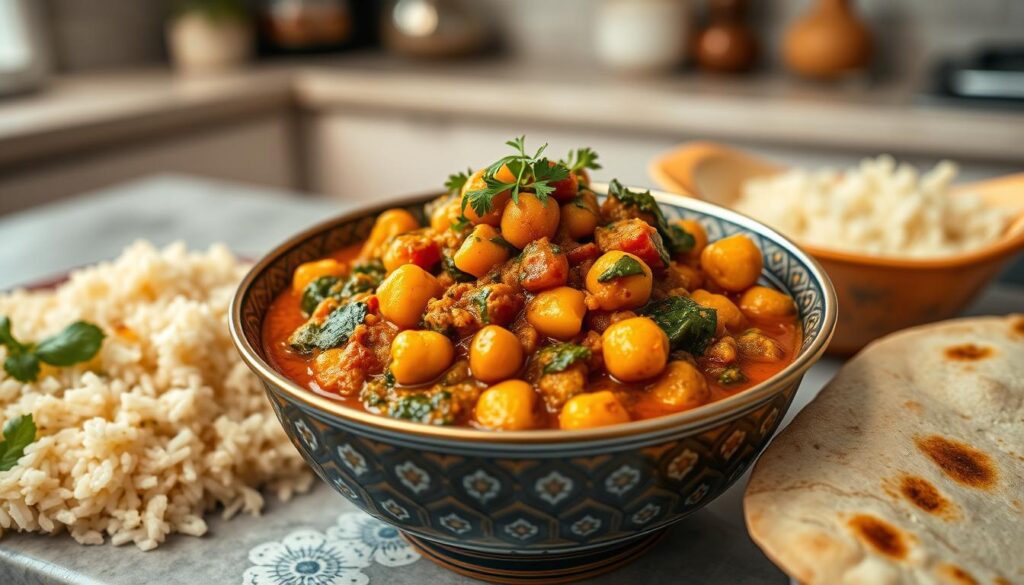
Discover the rich flavors of our Vegetarian Chickpea and Spinach Curry, a protein-packed delight. This curry is not only a treat for the taste buds but also provides a nutritious meal that’s perfect for vegetarians and meat-eaters alike.
Ingredients List
The key ingredients include chickpeas, spinach, and a blend of aromatic spices. You’ll need:
- 1 can chickpeas
- 2 cups fresh spinach
- 1 onion
- 2 cloves garlic
- 1 tablespoon curry powder
- 1 can coconut milk
Step-by-Step Preparation
To prepare this curry, start by sautéing the onion and garlic until softened. Then, add the curry powder and cook for another minute. Next, add the chickpeas, spinach, and coconut milk. Let it simmer until the spinach is wilted and the flavors are well combined.
Serve hot over rice or with naan bread for a satisfying meal.
Nutritional Information and Protein Content
This Vegetarian Chickpea and Spinach Curry is not only delicious but also packed with protein from the chickpeas. Spinach adds a boost of vitamins and minerals, making this dish a nutritious choice. A serving provides approximately 20 grams of protein, making it a great option for those looking to increase their protein intake.
Greek Yogurt Breakfast Bowl with Seeds and Berries
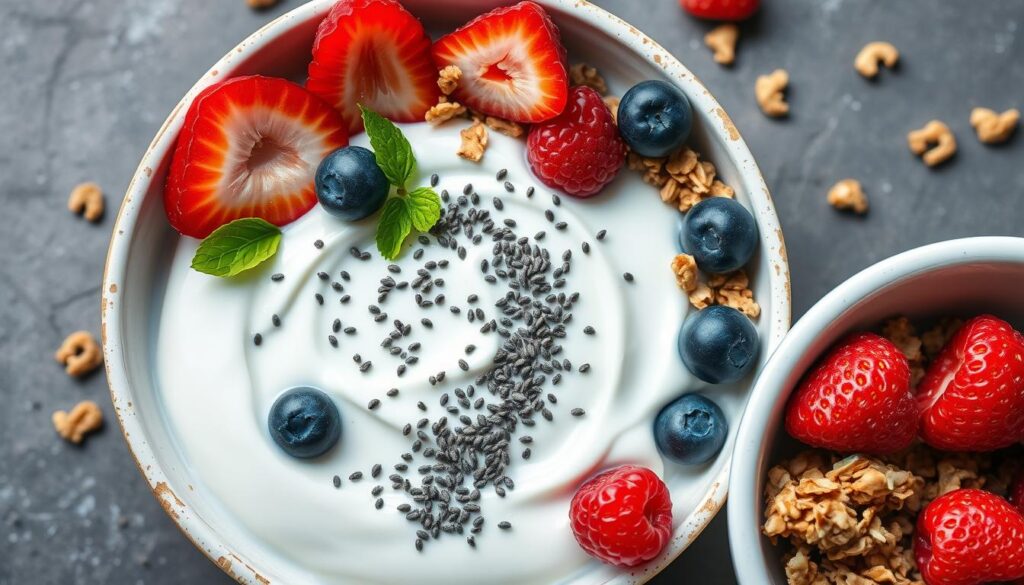
Transforming your breakfast routine with a protein-packed Greek yogurt bowl can have significant health benefits. This simple yet nutritious meal combines the creaminess of Greek yogurt with the crunch of seeds and the sweetness of berries, providing a balanced mix of protein, healthy fats, and carbohydrates.
Ingredients
The ingredients for this breakfast bowl include 1 cup of Greek yogurt, 2 tablespoons of chia seeds, 1 tablespoon of honey, 1/2 cup of mixed berries, and 1/4 cup of granola. You can also customize it with your favorite seeds and berries.
Preparation
To prepare this breakfast bowl, start by layering Greek yogurt in a bowl, then add chia seeds and mixed berries on top. Drizzle with honey and sprinkle granola for added crunch and flavor. This breakfast bowl is quick to assemble and can be made ahead of time.
Nutrition
This Greek yogurt breakfast bowl is not only delicious but also packed with nutrients. It provides approximately 20 grams of protein, along with probiotics, fiber, and antioxidants. The combination of yogurt and seeds makes it a nutritious start to your day.
Steak with Beans and Roasted Vegetables
Elevate your dinner game with a mouth-watering steak paired with beans and roasted vegetables, a perfect blend of protein and flavor. This recipe is not only delicious but also packed with nutrients.

Ingredients List
The ingredients for this hearty recipe include a tender steak, a variety of colorful vegetables for roasting, and a side of beans for added protein. You’ll also need some basic pantry staples.
Step-by-Step Preparation
Start by seasoning the steak to your liking and grilling it to perfection. Meanwhile, toss your chosen vegetables with olive oil, salt, and pepper, and roast them in the oven until tender. Cook the beans according to your preference, either by boiling or sautéing them with some onions and garlic. Serve everything together for a well-rounded meal.
Nutritional Information and Protein Content
This meal is not only flavorful but also offers a significant amount of protein, with approximately 48 grams per serving. The roasted vegetables add fiber and vitamins, while the beans contribute to the overall protein content and provide complex carbohydrates.
Time-Saving Tips for High-Protein Meal Prep
High-protein meal prep doesn’t have to be time-consuming with the right strategies. By implementing efficient meal preparation techniques, you can save time while maintaining a diet rich in protein. Stocking your fridge with pre-cooked chicken is a great starting point, as it can be easily mixed into various dishes such as rice, tortillas, or salads.
Batch Cooking Strategies
Batch cooking is an effective way to prepare high-protein meals in advance. Focus on cooking protein-rich foods like chicken, beans, or lentils in bulk. These can be used throughout the week in different meals, reducing overall cooking time. For instance, a large batch of cooked chicken can be used in salads, wraps, or as a topping for vegetables.
Smart Storage Solutions
Proper storage is crucial for maintaining the quality and safety of prepped meals. Use airtight containers to store cooked proteins and keep them in the refrigerator or freezer. Labeling containers with dates can help you keep track of freshness. The following table illustrates a simple meal prep plan and storage strategy:
| Meal Prep Day | Protein Cooked | Storage Method | Meal Ideas |
|---|---|---|---|
| Monday | Chicken Breast | Refrigerate | Salads, Wraps |
| Wednesday | Lentils | Freeze | Soups, Stews |
| Friday | Turkey Burgers | Refrigerate | Burgers, Sandwiches |
By adopting these meal prep strategies, you can enjoy a variety of high-protein meals while saving time during the week. Efficient cooking and storage techniques make it possible to maintain a healthy, protein-rich diet even with a busy schedule.
Customizing Recipes for Dietary Restrictions
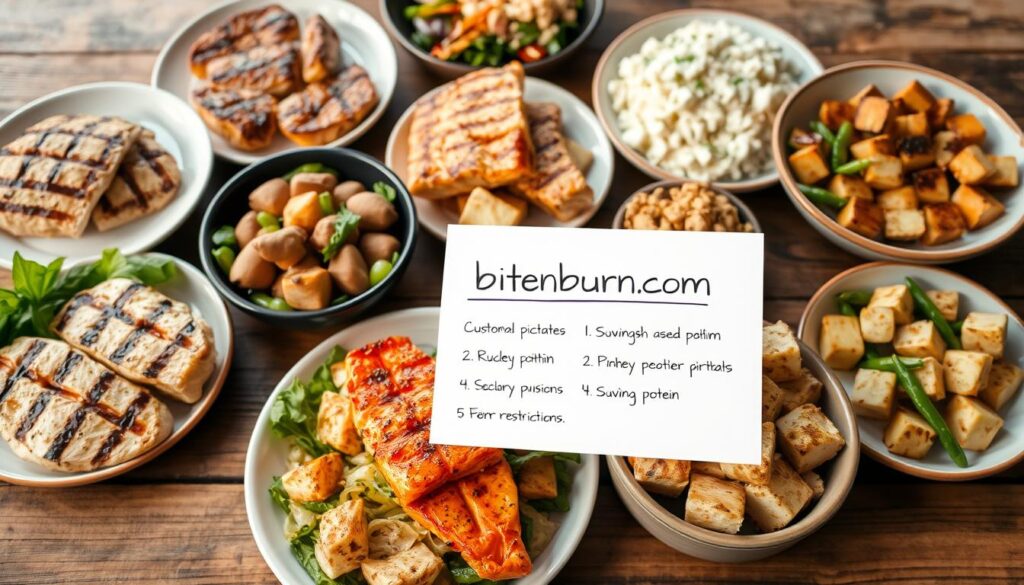
Customizing high-protein recipes for dietary restrictions is easier than you think. With a few adjustments, you can enjoy your favorite dishes while adhering to your dietary needs.
When dealing with dietary restrictions, it’s essential to identify the right ingredients. For instance, those with gluten intolerance can opt for gluten-free protein options. Naturally gluten-free protein sources include lean meats, fish, eggs, and certain grains like quinoa and rice.
Gluten-Free Protein Options
To maintain a high protein content in gluten-free recipes, focus on incorporating protein-rich ingredients. Here’s a comparison of gluten-free grains and their protein content:
| Gluten-Free Grain | Protein Content per Serving |
|---|---|
| Quinoa | 8g |
| Rice | 2g |
| Buckwheat | 6g |
Dairy-Free Alternatives
For those who are lactose intolerant or prefer a dairy-free diet, there are numerous dairy-free alternatives available. Plant-based milks, yogurts, and cheeses can replace traditional dairy products in high-protein recipes. When choosing dairy-free alternatives, consider the nutritional differences to ensure you’re getting adequate protein.
By understanding how to adapt recipes and exploring different protein options and alternatives, you can enjoy a varied and nutritious diet that meets your protein needs, regardless of your dietary restrictions.
Boosting Protein Content in Everyday Meals
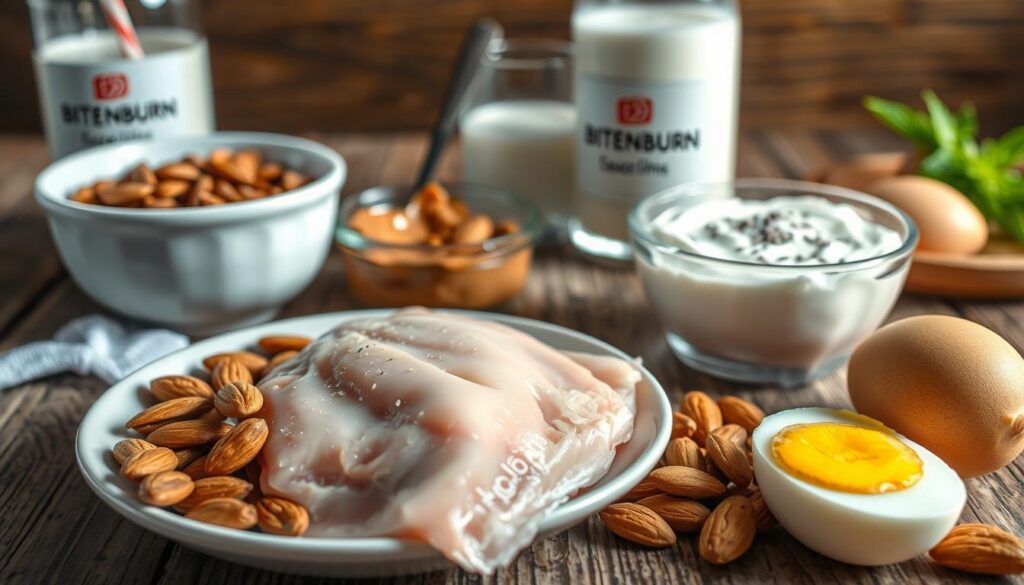
Discover how to increase the protein content of your daily meals without overhauling your diet. Boosting protein intake can be achieved through simple, effective strategies that fit into your existing meal routine.
You can enhance your meals by incorporating high-protein ingredients or making strategic substitutions. This approach allows you to maintain your favorite dishes while upgrading their nutritional content.
Simple Add-Ins for Extra Protein
Add nuts, seeds, or legumes to your food for an extra protein boost. For example, sprinkling almonds on your oatmeal or adding chickpeas to your salad can significantly increase the protein content.
Protein-Rich Substitutions
Replace refined grains with protein-rich alternatives like quinoa or amaranth. You can also substitute low-protein ingredients with higher protein options, such as using Greek yogurt instead of regular yogurt, enhancing the nutritional content of your meals.
Balancing Flavors in High-Protein Dishes
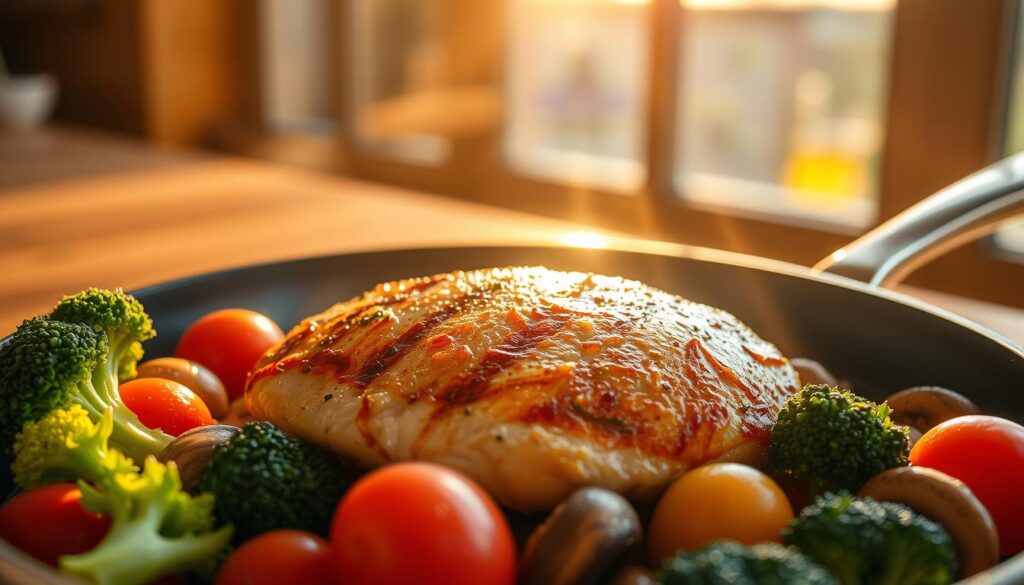
Balancing flavors in high-protein meals is an art that enhances the dining experience. Achieving the right balance of flavors can elevate a dish from good to great, making it more enjoyable and satisfying.
To create well-rounded high-protein dishes, it’s essential to understand how to enhance the natural flavors of protein-rich foods without relying on excessive salt, sugar, or fat. One approach is to use herbs and spices that complement different protein sources. For instance, Cajun seasoning adds a spicy flavor profile to dishes, while gochujang—a Korean red chile paste—can add both sweetness and heat.
Herbs and Spices That Complement Protein Foods
Different herbs and spices can significantly enhance the flavor of protein-rich foods. For example, chicken pairs well with herbs like thyme and rosemary, while tofu can be flavored with a variety of spices, including cumin and coriander. Experimenting with different herb and spice combinations can help you discover new flavors for your favorite protein dishes.
- Use basil and oregano for a Mediterranean twist on chicken or fish.
- Add cumin and chili powder for a Mexican-inspired flavor on beef or tofu.
- Try ginger and garlic for an Asian-style marinade on salmon or chicken.
Creating Satisfying Texture Combinations
In addition to balancing flavors, creating a variety of textures within a dish can make it more satisfying. Techniques such as achieving crispy exteriors and tender interiors can add depth to a protein-focused dish. Combining protein with different vegetables and grains can also provide a pleasing contrast in textures.
For example, pairing grilled chicken with roasted vegetables and quinoa not only provides a balance of flavors but also a satisfying mix of textures. Incorporating elements like nuts or seeds can add crunch, while using creamy sauces or yogurt can add smoothness.
By balancing flavors and textures, you can create high-protein dishes that are not only nutritious but also delicious and engaging. Experimenting with different seasoning combinations and cooking techniques can help you develop a repertoire of tasty and satisfying meals.
Kid-Friendly High-Protein Recipe Adaptations
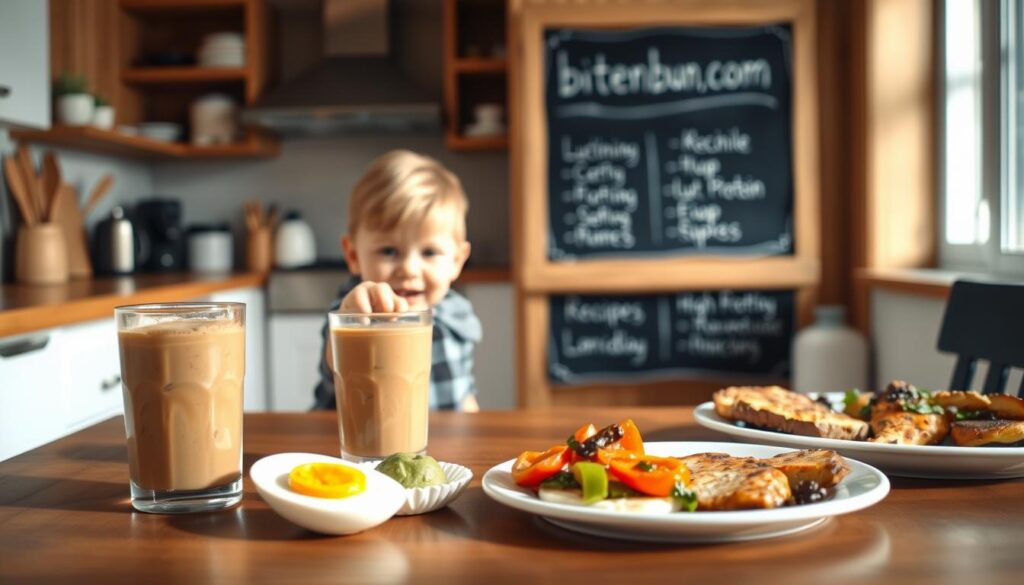
Making high-protein recipes appealing to children can be achieved through various adaptations. Topped with pickled cabbage and tahini-yogurt sauce, these Lebanese meat-stuffed pitas make for a hearty, handheld meal that will please the whole family.
Nutritional Tweaks for Kids
To make protein foods appealing to children, it’s essential to understand their taste preferences and dietary needs. Start by introducing new protein sources gradually, pairing them with familiar flavors and textures.
- Use mild seasonings and avoid strong flavors that might be off-putting.
- Involve children in meal preparation to increase their interest in trying new foods.
- “Hide” additional protein in kid-favorite dishes without altering their appearance or taste.
Creative Presentation for Young Eaters
Presentation plays a significant role in making high-protein foods appealing to children. Here are some fun ideas:
- Create shapes with protein-rich foods like eggs or chicken.
- Use colorful vegetables to add visual appeal.
- Serve protein foods in fun, kid-friendly containers or wraps.
Understanding age-appropriate protein needs is crucial. Ensure children get adequate protein through appealing foods by adapting recipes to their tastes. For instance, a simple protein-packed meal like a Greek yogurt parfait with granola and berries can be a hit with kids.
Budget-Friendly Protein Shopping Tips
Maximizing your protein intake on a budget is achievable with the right shopping techniques. By being mindful of your grocery shopping, you can enjoy a high-protein diet without breaking the bank.
To start, it’s essential to identify economical protein sources. Options like beans, lentils, and eggs are not only rich in protein but also budget-friendly. Canned tuna and chicken are other affordable alternatives that can be incorporated into various meals.
Economical Protein Sources
Some of the most cost-effective protein sources include plant-based options like chickpeas, black beans, and lentils. These can be used in a variety of dishes, from curries to salads. For animal-based proteins, consider buying in bulk or opting for cheaper cuts of meat.
| Protein Source | Cost-Effectiveness | Nutritional Value |
|---|---|---|
| Lentils | High | Rich in protein and fiber |
| Canned Tuna | Medium | High in protein, omega-3 fatty acids |
| Eggs | High | Complete protein source, versatile |
Seasonal Shopping Strategies
Shopping for protein sources that are in season can significantly reduce costs. For example, buying chicken or fish during sales periods can be more economical. Additionally, consider freezing items like vegetables and meats when they’re on sale to use later.
Don’t forget to utilize leftovers and plan meals around what’s on sale. By adopting these budget-friendly protein shopping tips, you can maintain a healthy, high-protein diet without overspending.
Common Mistakes When Cooking High-Protein Foods
Achieving perfectly cooked protein can be tricky, and understanding the most common mistakes is key to improving your cooking skills. Cooking protein requires attention to detail to avoid common pitfalls.
When preparing protein-rich foods, several factors come into play, including cooking techniques and the risk of making mistakes that can affect the final product.
Avoiding Overcooking Protein
One of the most common mistakes is overcooking protein, which can make it tough and dry. To avoid this, it’s essential to understand the optimal cooking techniques for different types of protein, such as chicken, fish, or beef.
- Use a thermometer to ensure the correct internal temperature.
- Don’t overcrowd the cooking surface, as this can lower the temperature and lead to uneven cooking.
- Let the protein rest after cooking to allow the juices to redistribute.
Proper Seasoning Techniques
Proper seasoning is crucial for bringing out the natural flavors of protein. This involves more than just adding salt and pepper; it’s about using the right techniques at the right time.
- Season protein before cooking to allow flavors to penetrate.
- Use a mix of herbs and spices to complement the natural flavor of the food.
- Taste as you go and adjust seasoning accordingly.
Conclusion: Incorporating High-Protein Meals Into Your Weekly Routine
Making protein-rich meals a part of your weekly routine is simpler than you think, and it’s packed with benefits. By incorporating the five high-protein recipes outlined in this article, you’ll not only boost your overall nutrition but also experience the benefits of feeling fuller for longer and stabilizing your blood sugar levels.
These recipes demonstrate that high-protein cooking doesn’t require specialty ingredients or advanced culinary skills. They’re versatile and can be adapted to suit different taste preferences and dietary needs, making it easy to create a balanced weekly meal plan.
By experimenting with your own variations using protein sources you enjoy, you’ll be able to maintain a healthy diet with ease. With these simple and delicious meals, you’ll be well on your way to supporting muscle maintenance, metabolism, and overall satiety. Start incorporating these meals into your routine today and experience the positive impact on your overall health.


[…] vegan diet full of high-protein foods can change the game for weight management. Protein is key. It helps build and repair muscles, keeps […]
[…] relying on basic ingredients like canned tomatoes, dried lentils, and a source of protein, you can create a variety of delicious and nourishing meals. In this article, we’ll explore […]
[…] Nuts and seeds, rich in healthy fats and proteins […]
[…] kitchen staples support overall wellbeing and may help prevent chronic […]
[…] role in setting a positive tone for the rest of the day. With a bit of planning and the right recipes, you can create a nutritious meal in just […]
[…] seeds contain high-quality protein that helps build muscle and boost metabolism, making them an excellent addition to any weight loss […]
[…] your immunity can be as simple as reaching into your kitchen for the right foods. Incorporating specific foods into your diet can strengthen your immune […]